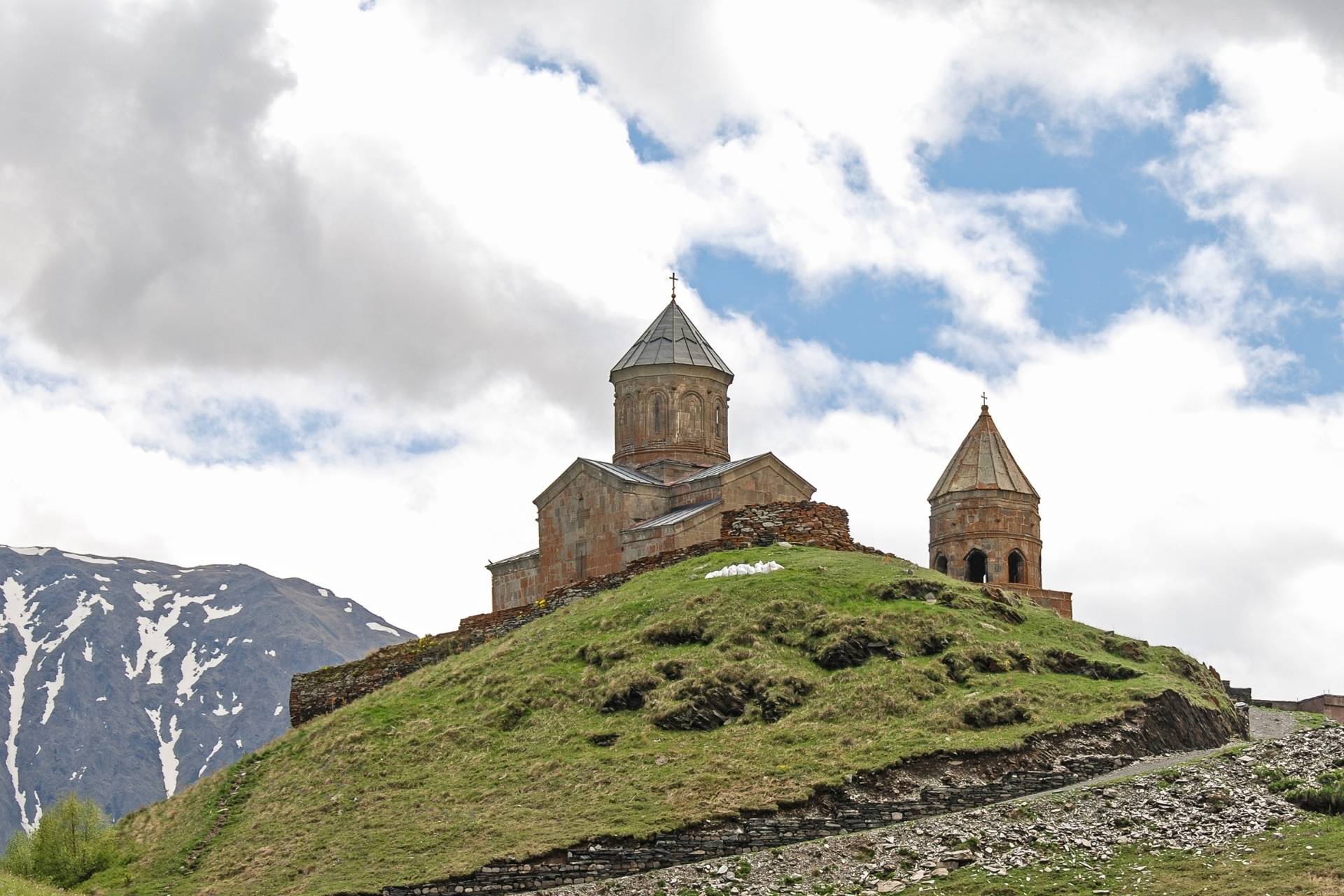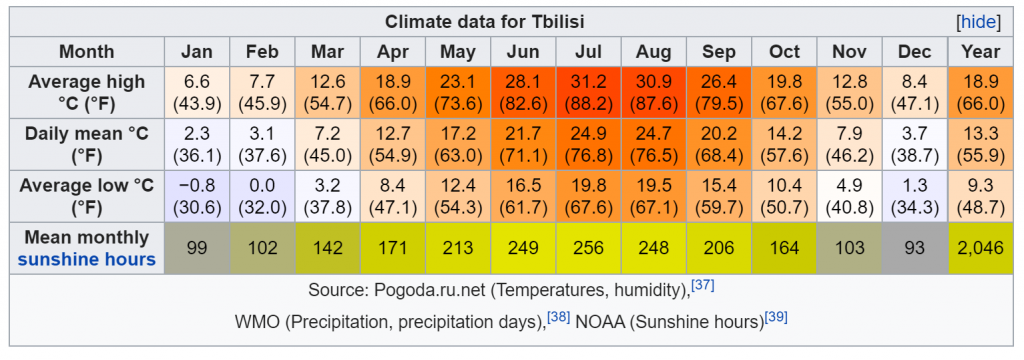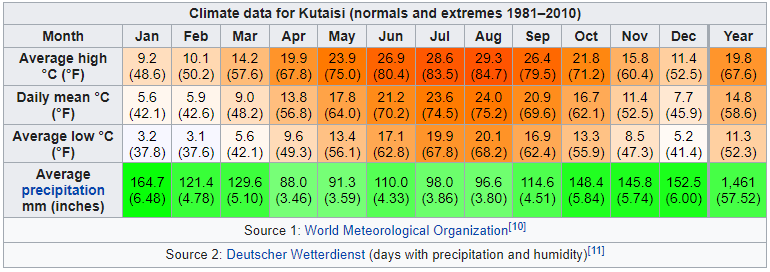What’s the Weather Like in Georgia? Unsurprisingly, this is among the first questions that would-be expats tend to ask before deciding on moving to Georgia (or, indeed, any other country!)
It’s no surprise, either. Anecdotal evidence certainly suggests that a better climate is among the top reasons people move abroad in the first place.
And who can blame them? When you can replace rainy days with warm, sunny weather (well, at least, in most of the cities in Georgia), and save money by doing it, why wouldn’t you?
Georgia Isn’t a Year-Round Paradise, Though
While summers in Georgia are indeed incredibly pretty (and also long), it still gets rather nippy in the winter! If enjoying the seasons is your preference, rather than expecting 12 months of tropical beach weather, Georgia will satisfy.
Because Georgia has 12 different climate zones, this small country has a lot of diversity, from the high mountains to the subtropical Black Sea coast. So you need to consider the exact area you will live in, in order to understand the weather patterns unique to that region. Below we cover the general weather conditions and some of the most popular places to live.
General Summary of Weather in Georgia
Summer: The busiest tourist season is from June to mid-September. Expect hot weather (30+ Celsius/86+ Farenheit is typical) and plenty of dry days with blue skies and minimal clouds. Head to the mountains or the Black Sea coast to cool off.
Spring & Autumn (Fall): Very pleasant temperatures, in the 20 degree Celsius (68 Farenheit) range in Tbilisi. Both seasons can have rain. These are both considered the shoulder seasons. October/November are often sunny, whereas March/April can be the wettest months and still quite cold during some years. May and September are typically glorious.
Winter: Tbilisi is typically dry with a reasonable amount of sunny days. Batumi will be wet but with milder temperatures. Ski resorts officially open around early/mid-December, though in practice many won’t open until mid to late December.
Personally, I consider May, September, and October to be my favorite months. Daytime temperatures mostly always fall under 30 degrees Celsius (86 Farenheit), so life is much more pleasant than it is during the heat of the summer, but it’s still warm enough to enjoy most evenings in a t-shirt.
In comparison to the UK and most places in the US Northeast, you’ll find the winter temperatures in Georgia to be similar to what you might be used to back home. The difference is that winter lasts for a much shorter period, and is accompanied by less wind and rainfall.
Weather In Georgia – As Diverse As Its Culture
It pays to keep in mind, especially if you’re originally from a relatively flat country, that mountainous Georgia has many different sub-climates.
While Tbilisi is relatively moderate and dry, other places like Batumi get their fair share of wind, humidity, and rainfall. For example, Batumi is among the places which receive the most rainfall in all of Europe and Central Asia – with the yearly total standing at 2,435mm (95 inches), while the average yearly rainfall in Tbilisi is as low as 495mm (or 19 inches).
If you look beyond the big cities to the other regions of Georgia, you will discover that just like Tbilisi and Batumi, they have vastly different climates. Up in the mountains, for instance, you can easily find towns that have steady snow-cover for nearly half the year.
While I don’t consider the weather to be the main selling point of Georgia, the level of diversity means that you can typically find weather around the country that will suit almost anyone for most of the year, and the winters away from the mountain areas are mild compared to Northern Europe, Canada, etc.
Georgia’s climate is as diverse as its culture, and to get the full Georgian experience, you should visit all of the different regions at least once. We will go over each region of Georgia in further detail, outlining the unique local climates, what they look like throughout the year, and what the best times to visit are.
Tbilisi
Tbilisi is a city where you can experience both hot summer days and moderately cold winters, though it tends to be fairly dry year-round. It’s a classic 4-season city.
Of course, there’s more to the ideal climate than just average temperatures. Wind and rainfall are also very influential factors. I don’t know about you, but I don’t mind slightly colder temperatures for one. You can get yourself a comfortable coat, and you won’t even notice that it’s 3 degrees outside. It’s when it’s pouring rain for days on end and the cold is accompanied by hurricane-strength winds that things turn nasty, which is not really a concern in Tbilisi.
Luckily, Tbilisi is also very appealing in terms of both rainfall and wind. The city rests in a valley, so the weather is milder than in other regions. The average yearly rainfall here is just 495mm (19 inches), with the yearly average number of rainy days around 71. Compare this to London, where the corresponding yearly figures are 601mm (23 inches) and 110 days, respectively.
There’s also much more sunshine in Tbilisi than in many other places in Europe, with over 2,000 average monthly sunshine hours (for comparison, London stands at 1,632 and Berlin at 1,727).
What is the best time to visit Tbilisi? Well, it depends, as you can have a pleasant time in the city almost whenever you want. But, if we’re talking about the absolute most ideal seasons to visit, then probably it will be the mild periods from May to June and from September to October. In short, both spring and autumn are warm (but not too sunny) and full of cultural events.
For example, on May 26th you can attend Independence Day celebrations and see military parades on the main city streets. In autumn, Tbilisoba (early October), or the celebration of the city, is waiting for you with food trucks and wine tastings. Both seasons are ideal times to visit Tbilisi, with pleasant weather and interesting cultural events ready to enjoy.
Batumi
Batumi weather is very much like English (UK) weather; one minute it can be sunny and people will flock to the beach, and by the next, there is a massive rainstorm that lasts for a week. Batumi is extremely humid due to its proximity to the sea. Because of this, the weather here is chaotic and sometimes very unpredictable.
Spring in Batumi is mostly pleasant, featuring warmer weather and a decrease in rainfall. Summers can get extremely hot due to the mountains in the east trapping winds and heat in the region, so it is quite common to have warm windstorms followed by heavy rains.
Autumn in Batumi is when things start to change rapidly. The weather is all over the place. Half a week can be sunny and warm, and the rest will be cold, cloudy, and rainy. Winter is a little more predictable. It’s mostly cloudy but can get bone-chillingly cold. Snow is rare in Batumi, but when it does snow, as a result of the heavy moisture in the air, it snows heavily and can last up to a week.
The best time to visit Batumi is from approximately mid spring to mid autumn, so that you can enjoy strolling around the botanical gardens, swimming in the Black Sea, and dining at outdoor cafes.
Kakheti
The entire Kakheti region is so popular with expats and tourists alike that we’ve mentioned the area in general instead of focusing on any one particular city it contains. That reason of course is… Wine. Kakheti is Georgia’s most popular wine region, and recieves huge amounts of visitors all from May to October. It’s especially popular during “Rtveli”, the wine harvest festival involving picking grapes in vineyards and partaking in the traditional winemaking process (followed by hearty feasting & toasting). This annual custom takes place almost everywhere in Kakheti in September & October. If we want to understand the climate of Kakheti, we only need to look at one city to know what to expect, and if you’re into wine, you probably already know that this city can’t be anywhere but Telavi.
As the municipal capital of Kakheti, Telavi is also located in eastern Georgia, so almost everything I previously stated about Tbilisi is true for this region as well. As you can see from the chart, summers are typically very hot in Telavi, but it also rains more than in Tbilisi, which helps to make the land so ideal for agriculture. However, rain is not the only thing one should expect in Kakheti. As a rule, hail comes at least once a year.
Kakheti is a very warm destination from May to October, so the weather usually won’t be a problem if you’re hoping to pick some grapes and do some al fresco wine tasting.
In conclusion, the Kakheti region is synonymous with wine production in Georgia, so if you ask which is the best time to visit Kakheti, the answer will always be in September, during the peak harvest season.
BTW we also offer specialist, small group artisan wine tours via our partner company Eat This! Food & Wine Tours. Join us for a tour!
Kazbegi
Unlike Kakheti, there’s a significant difference between the climates in Tbilisi and Kazbegi, and specifically Kazbegi’s main settlement, Stepantsminda. In contrast to the previously mentioned places, Kazbegi is extremely mountainous and snowy.
See all the blue in the chart above? That’s an accurate representation of just how cold Kazbegi really is. Its location in the steep Caucasus mountains means that even in summer the weather tends to remain quite cool.
The best time to visit Kazbegi is probably summer, not just because the weather will be more enjoyable than in winter, but also because you can freely visit its unique sights which might be hard to access due to snow at other times of the year, such as the stunning Gergeti Trinity Church.
Mestia (Svaneti)
Just like Kazbegi, Mestia is also located in northern Georgia, deep in the Caucasus mountains. It’s even colder there than in Stepantsminda, and the average temperatures in winter fall around -10 Celsius (14 Fahrenheit). Mestia is one of those Georgian towns that has a steady snow-cover for nearly half the year.
Summer in Mestia starts in June and ends in late September. But it can’t be compared to “summer” in other regions of the country, as the average temperature is only around 10-14 Celsius (50-57 Fahrenheit). Certainly, Mestia serves as a cool escape for those overheated by the sweltering summer heat in Tbilisi, Batumi, or other major Georgian cities.
The best time to visit Mestia is in July or August, as they’re the warmest months, and the best opportunity for visitors to explore the beautiful natural scenery that this mountain region has to offer. However, there are also some skiing options to explore if visiting in the winter.
Kutaisi (Imereti)
The climate in Kutaisi is warm and temperate. However, the rainfall in Kutaisi is significant, with precipitation falling even during the “driest” months. Kutaisi is located in the North-Eastern top of the Western Georgian plains. In summer, there can be instances when the weather here is a few degrees hotter than even that of Batumi.
Spring to Autumn can be pretty moderate, with no significant temperature hikes. However, the winter can get pretty cold with occasional snowfall.
The best time to visit Kutaisi would be from early spring (around late February / mid March) to late Autumn (approximately late November / early December). During this time the weather is most ideal for sightseeing and enjoying the attractions of the region. July/August can be particularly hot and humid and not as pleasant as the months either side.
Borjomi
Hottish days and cool nights are what you can expect from Borjomi in summer. It has a dry climate which makes it a popular vacation spot. Winter is not exceptionally cold in Borjomi, but the region does tend to see a little snowfall each year.
When it comes to the ideal seasons to visit Borjomi, there are a lot of options. Its weather is so pleasant year-round that you can find advantages to visiting in both the sunny summer season and the beautiful (albeit not too cold) wintry season. So, we heartily recommend that you visit in both seasons!
Continue to a higher altitude from Borjomi to the small town of Bakuriani, where you’ll find skiing in the winter season.
Weather in Georgia – The Final Word
In conclusion, it’s safe to say that while Georgia’s climate may not be like that of Malaysia or Costa Rica, it’s still both pleasant and diverse. Overall, you aren’t likely to be disappointed, so long as you know what to expect and how to prepare in order to best enjoy the weather in each region.
If you’re someone who appreciates having four distinct seasons and the opportunity to go from cold mountain terrain to warm seaside weather in a day (as well as everything in between), Georgia may be ideal for you. While the Caucasus region may not offer year-round tropical weather, it’s certainly never boring!
Get Our Full Georgia Expat Guide
Our free eBook covers the essentials of living in, or relocating to, Georgia. Our 100+ page guide includes:
- Accommodation and where to live in Georgia & Tbilisi.
- Visas & residency.
- Business, banking, & tax.
- Everyday life: from social life to transport, internet, restaurants, and much more.
Download your free copy of our eBook:






